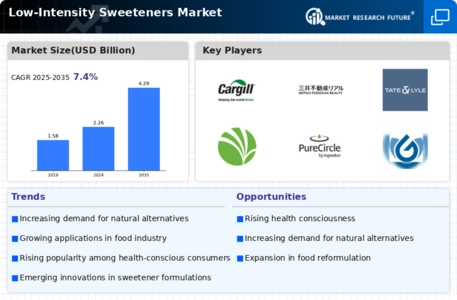Top Industry Leaders in the Low Intensity Sweeteners Market

The low-intensity sweeteners market has witnessed a surge in demand owing to the increasing focus on healthier alternatives to traditional sugars. This burgeoning industry is defined by a competitive landscape, with various players striving to capitalize on shifting consumer preferences towards reduced-calorie and natural sweetening options.
Strategies Adopted
In the pursuit of market leadership, companies have adopted diverse strategies. Innovation plays a pivotal role, with an emphasis on developing natural and clean label sweeteners to meet the increasing demand for healthier alternatives. Additionally, strategic partnerships with food and beverage companies to incorporate low-intensity sweeteners into their products have become common. Moreover, branding and marketing efforts are crucial in creating consumer awareness and trust in these alternative sweeteners.
Market share analysis in the low-intensity sweeteners segment takes into account various factors. Product formulation and taste play a significant role, as consumers seek sweeteners that closely mimic the taste of sugar without the associated calories. Factors like price competitiveness, availability, and regulatory approvals also influence market share. Moreover, consumer perception of health benefits, such as diabetes management and weight control, impacts the adoption and market success of these sweeteners
Emerging Companies.
Amidst established players, new and emerging companies are making their mark by focusing on specific niches within the low-intensity sweeteners market. Startups and smaller firms often specialize in particular types of sweeteners or target niche consumer segments seeking unique taste profiles or specific health benefits. These companies innovate by leveraging advanced technologies to enhance the production process or by discovering novel sources for low-calorie sweeteners, aiming to capture a share in this growing market.
Industry news frequently highlights technological advancements and regulatory developments shaping the low-intensity sweeteners market. Innovations in production techniques, such as fermentation processes or enzymatic methods, contribute to the expansion of available sweetening options. Additionally, regulatory changes regarding sugar taxes or labeling requirements for food and beverages impact the market dynamics and influence consumer choices.
The current investment trends within the low-intensity sweeteners market focus on sustainability, technological advancements, and expanding production capacities. Companies are investing in research and development to improve the taste profiles of sweeteners and reduce production costs. Furthermore, investments in sustainable sourcing practices and eco-friendly production methods align with consumer preferences for ethical and environmentally conscious products.
Competitive Scenario
Overall, the competitive scenario in the low-intensity sweeteners market is evolving rapidly. Established players continue to dominate the market through their extensive resources and R&D capabilities, while new entrants strive to differentiate themselves through innovation and specialized offerings. The industry's trajectory is influenced by shifting consumer preferences for healthier alternatives, regulatory changes, and technological advancements. As the market continues to grow, companies will need to adapt swiftly, innovate consistently, and align with evolving consumer trends to maintain their competitive edge in this dynamic landscape.
Recent Development : Top of Form
The Key company established entities possess a global presence and offer an array of low-calorie sweeteners derived from sources like stevia, monk fruit, erythritol, and xylitol. Their strategies revolve around extensive research and development to innovate new sweetening solutions, strategic alliances with suppliers or manufacturers, and a focus on expanding their product portfolios to cater to diverse consumer preferences.
Key players dominating the low-intensity sweeteners Market
- Roquette Freres SA (France)
- Cargill Inc. (US)
- l. Du Pont de Nemours and Company (US)
- Mitsui (Japan)
- Matsutani Chemical Industry Co. Ltd. (Japan)
- Tate and Lyle (UK)
- Ingredion (US)
- NutraSweet Company (US)
- Südzucker AG (Germany)
- Purecircle (Malaysia)
- ZuChem Inc. (US)
- Food Chem International Corporation (Japan)
- Gulshan Polyols Limited (India)
- JK Sucralose Inc. (India)
- EcogreenOleochemicals (Singapore)


